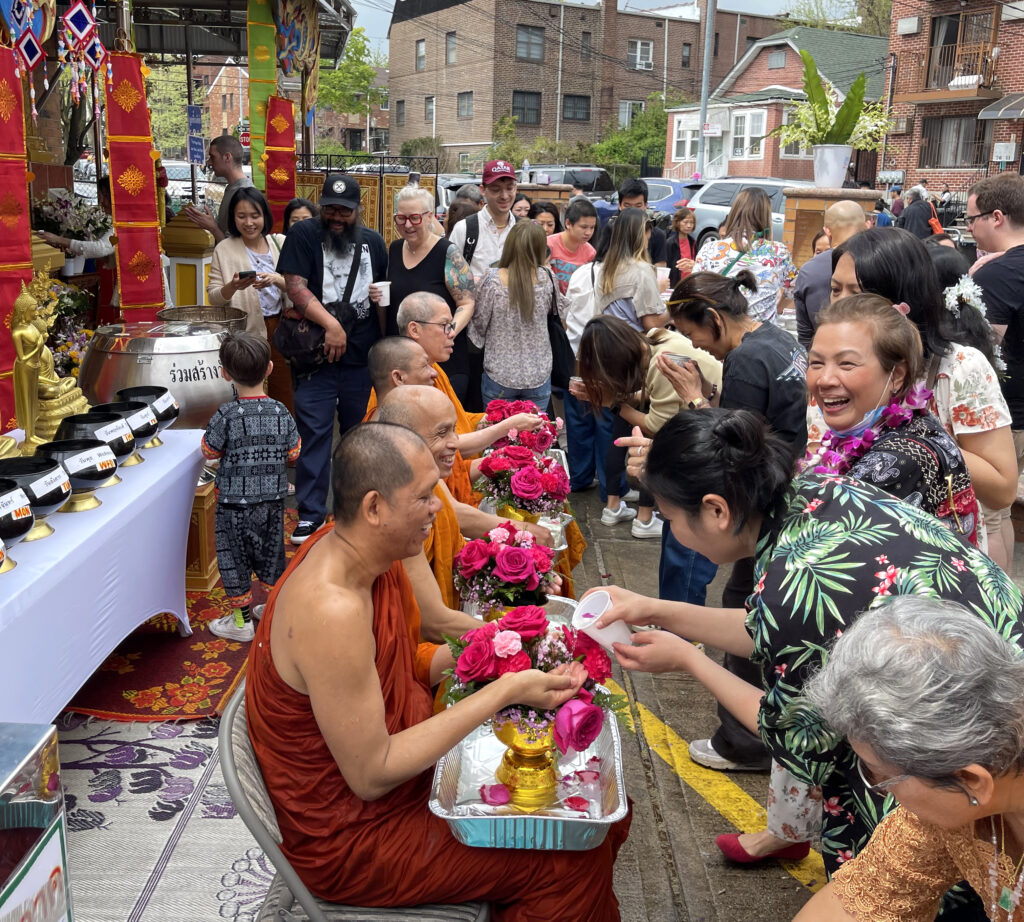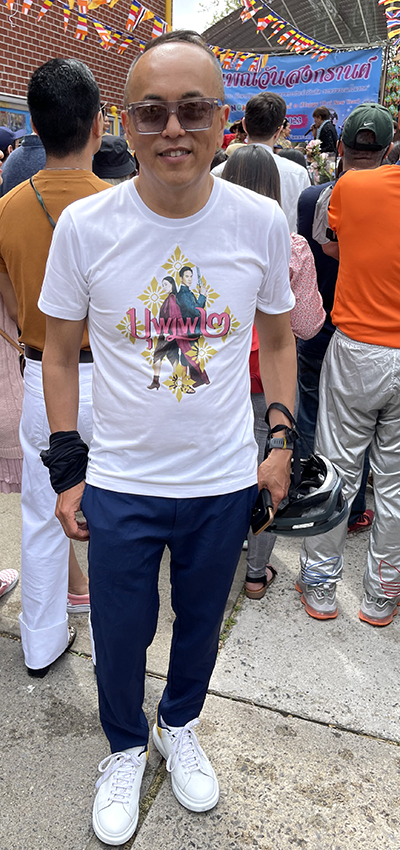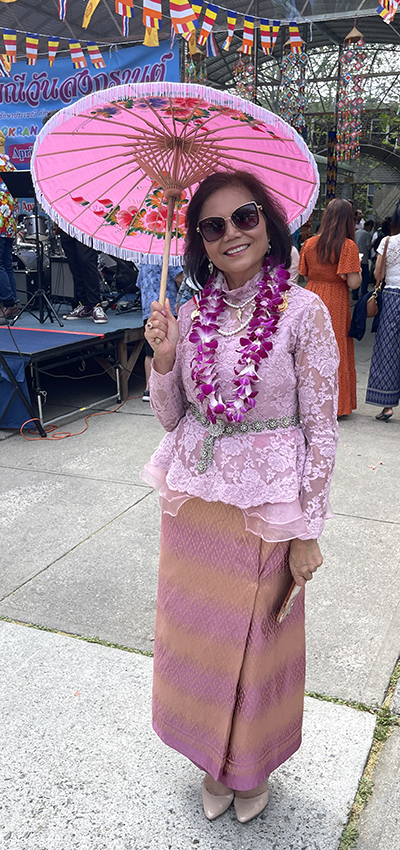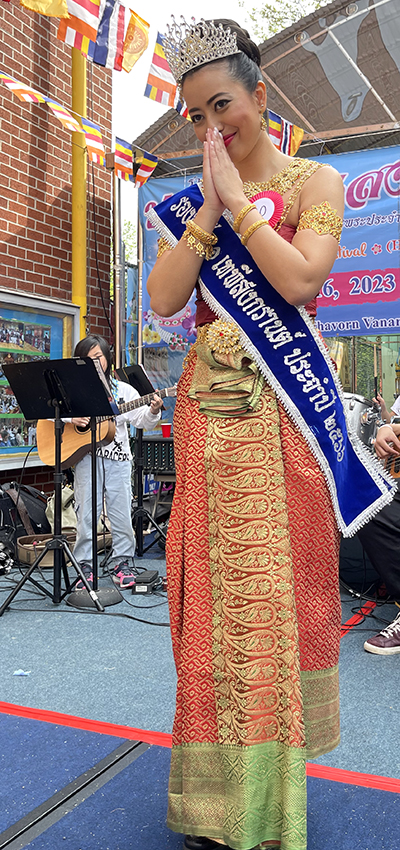New York’s Thai community celebrates Songkran and the designation of Little Thailand Way

August 24, 2023
A serpentine line was forming in front of the temple Wat Buddha Thai Thavorn Vanaram on 46th Avenue in Elmhurst, Queens, a little past 10 a.m. on a bright Sunday in April. In line stood a mix of Queens residents and visitors from the surrounding boroughs, waiting to offer morning alms and receive blessings from the procession of saffron-robed monks. A half-dozen elderly matrons dressed in pastel silk sabai gowns and carrying hand-crafted parasols were jovially chatting and complimenting each other on their looks and outfits. Close by, children were playing, splashing water from plastic pails and water guns, their hearty giggles filling the mid-morning air.
Aromas of garlic, basil, tamarind, and curry originated from the makeshift food stalls along the sidewalk where volunteers were busy plating fried rice, tom yum soup, green curry, and pandan coconut custard. By the temple’s front entrance, worshippers were performing a cleansing ritual, pouring water on the Buddha statue, and attaching dollar bills on a golden pagoda-shaped money tree. A duo of emcees glided up on stage, microphones in hand, gleefully announcing the commencement of the day’s festival in Thai and English: “Welcome to the annual Songkran New Year celebrations!”

“The word ‘songkran’ comes from the Sanskrit word meaning ‘movement’ or ‘passage,’” the emcees shared with the audience. In some ways, this year’s Songkran celebrations in Queens captured the key beats and movements that marked the celebrations of years past. It had all the customary elements—the sights, smells, and sounds—associated with the water festival: live music performances, Thai traditional dance, open-air food stalls, a beauty pageant, water fights, arts and crafts displays, prayer services, and monk merit offerings.
But in other ways, the festivities this year could be considered remarkable. They marked the first time in three years, since the pandemic, that full-fledged celebrations in honor of this holiday were held in the neighborhood. They were also monumental for being the first Thai New Year’s celebrations since the New York City Council’s approval of a bill in July 2022 designating “Little Thailand Way,” a Queens thoroughfare a few blocks from the temple. From 76th Street to 79th Street along Woodside Avenue, this stretch is the epicenter of Thai restaurants and shops in New York City.
With the designation, New York became only the second city in the U.S. to have an officially designated Thai ethnic neighborhood; the first was Los Angeles’s Thai Town, established in 1999. Little Thailand Way joins other ethnic group namings in New York City in recent years, including Little Bangladesh in Brooklyn and Little Manila Avenue in Queens. Cumulatively, these recent street namings reflect not only the vibrancy of the respective Thai, Bangladeshi, and Filipino communities, but also a significant step in redressing the lack of South Asian and Southeast Asian visibility relative to East Asian representation and in the political and cultural discourse at large.
For many in the community, the designation carries a deeper significance than the mere addition of a street sign: the title-case moniker bestows a formal recognition of the lived experiences and contributions of Thais who have sown roots in the city across generations. The name connects the dots of all the history and culture that a place and a community hold. For me, as a Thai American, a core part of me—my identity, my heritage, my language, my culture—finally feels seen by the city I have long considered home. As someone who has lived a hyphenated identity and often felt stuck in the borderlands, I take solace in this realization: there is now a place in New York proudly bearing my community’s name.
□ □ □ □ □

At the festival, I meet Juttana Rimreartwate (Khun Moo), who is known by many other Thai New Yorkers as the “unofficial mayor” of Little Thailand Way. Now in his mid-fifties, Khun Moo immigrated from southern Thailand on his own as a teenager in the 1970s to join his uncle in New York. Sporting a relaxed but polished look, wearing chinos, white sneakers, and a T-shirt printed with an image of Thai celebrities, Khun Moo tells me that he moved to the Americas to follow in the footsteps of his childhood hero, the Argentine revolutionary Ernesto “Che” Guevara. “I came to America in search of a greater purpose and to transform myself,” he says. “And similar to Che, I did so through traveling across the Americas as an impassioned youth.”
Over the years, Khun Moo’s political aspirations gave way to more practical concerns, and he pivoted to business entrepreneurship. In the 1980s, he gradually built up a portfolio of small businesses, including restaurants and grocery stores, mostly employing Thai immigrants.
Khun Moo has seen the Thai population in the city grow since he first arrived, likening the growth to that of the Chinese American community. “When I first came here, the Asian population was small and the only Chinatown location was in Manhattan,” he says. “Now, we have many Chinatowns in New York. Just like how the Thai community has expanded throughout New York City, where there are now hundreds of Thai restaurants and businesses.” The first significant wave of Thai immigrants arrived in New York in the sixties and seventies, and now they are among the fastest growing Asian ethnic groups. From 2010 to today, the Thai population in Queens has soared from approximately 3,700 to over 15,000. And the area has also seen an accompanying rise in Thai-owned restaurants, mini-marts, and shops.
During the pandemic, Khun Moo found a strong calling to do more for the community, and organized street fairs where food and produce could be sold outdoors. He worked with city administrators and the design firm Rockwell Group, which offered pro bono assistance in designing adaptable outdoor dining units that allowed food vendors to operate under the city’s health guidelines. “I felt like I had to do something, to give back to the community that had given me so much,” Khun Moo says. The success of these initiatives encouraged him and others in the community to petition for an official street designation.
In the lead-up to the naming of Little Thailand Way, Khun Moo collaborated with other community leaders, including city officials like Shekar Krishnan, New York City Council Member for District 25, with remit for Jackson Heights and Elmhurst, who cosponsored the bill to name Little Thailand Way. “The street naming is a reflection of our incredibly vibrant Thai community,” Councilman Shekar told me over a Zoom call a few weeks before Songkran. “It’s a recognition of the immense contributions of our Thai community, to our district, to Queens, and to New York City. And this recognition is long overdue for our entire community.”
When I ask him if some people find the designation merely symbolic or of limited impact, Krishnan disputes the idea: “It permanently changes the landscape of New York City,” he says, “and recognizes communities that have long been unseen and unrecognized in our city, especially Asian American communities.”
□ □ □ □ □
This wasn’t my first time at Wat Buddha Thai Thavorn Vanaram—I had been coming for decades—but it was the first time I could recall coming for such a large community gathering of several hundred people. I had moved to the city from Los Angeles in the late 1990s for college, and my memories of visiting the area predominantly involved me coming alone or with one or two classmates. I recall spending my weekends in Queens, taking the 1 train from the Upper West Side, changing to the 7 in Times Square, and getting off at Elmhurst’s 74th Street station. My usual first stop was this temple, the main Thai Buddhist temple in Queens, founded in 1994. I’d head upstairs to pray to the Emerald Buddha Shrine and sometimes engage in a short meditation of five to ten minutes. Afterwards, I’d walk to SriPraPhai, one of the oldest and largest Thai restaurants in Queens and the ultimate go-to place for my friends and me for the taste and feel of a home-cooked meal.

Back then, my near-weekly excursions to the Woodside-Elmhurst area felt like a solitary affair. Even when I was with friends, I came to view the area as a hideaway, siloed off from the rest of my city life. Each visit was an escape, a respite from the stresses and demands of college, then law school, then a law firm job. When I crave Thai food, I go there.When I need to meditate and de-stress, or when I get bored or homesick, I head to the neighborhood. In essence, the one-mile or so radius of blocks in Woodside and Elmhurst became my private little Bangkok.
But on this day, instead of solitude, I felt a warm sense of community and togetherness celebrating Songkran. Though I came alone, I met several people whom I knew, including Columbia undergraduates Boss and Sani, whom I had met at an alumni-student mixer the week before. I also made new friends. After the worship services, I came out to the stage area and saw a lady holding up a parasol. Her name, I would learn, was Boonyaporn Eady Green, known among the community as “Khun Eady,” and she’s lived in the tristate area for the past thirty years. In addition to her day job in real estate development, Khun Eady organizes group visits to Thai temples and community centers in all five boroughs of New York, as well as New Jersey and Pennsylvania. She found the festivities particularly exciting this year given the recent Little Thailand Way designation. “The designation is something we’ve been pushing for for many years, and it means a lot for me and others who for decades have made New York a home away from home.”
After chatting with Khun Eady, I spent the next hour with Khun Moo, who walked me around the festival, introducing me to his friends—around twenty-five people, ranging from the volunteer cooks to monks to food critics. At the end of his round of introductions, we stood in front of the stage and watched part of the Miss Songkran beauty pageant. We both knew one of the contestants, Bri Cea, a social justice advocate of Thai, Korean, and Chinese descent who had moved back to the area last year after living in Brooklyn. We both left before the crowning, and later that night, I received news that Bri had won the runner-up title of Miss Songkran.

In an Instagram post that evening, she dedicated the title to her late grandmother, who had been among the first generation of Thai immigrants in New York and had operated, in the 1980s and 1990s, a beauty salon on 74th Street and Broadway in Jackson Heights, close to Bri’s current apartment. “I know that Grandma Pensri was looking out for me again,” her post read. “Everyday, I look out my window, I see the old salon sign and I pray that I am making her proud. Every time I go to the same temple that she used to pray at, I think of her.”
Bri, who is the president of the Organization of Chinese Americans-Asian Pacific American Advocates in New York and the executive director and founder of Generation Vote, believes the designation marks progress for the Thai community. “The designation of Little Thailand Way represents both a historic recognition of Thai New Yorkers’ contributions to New York City—just like my grandmother—and a call to future generations to continue spreading awareness about our beautiful community,” she said. “It is important that we get involved and advocate for funding to support Thai businesses, affordable housing for Thai immigrants, and increased language access for social services in our neighborhoods.”
Looking ahead, Bri views the designation as part of a broader campaign push to develop and vitalize the community, including increasing dialogue and collaboration between the neighborhood and public officials: “I look forward to working with our elected officials and community leaders to make our community a staple in New York’s cultural and civic spaces.”
□ □ □ □ □
A week after the Songkran festivities at Wat Buddha Thai Thavorn Vanaram, I returned to Woodside, this time to attend a street gathering for Earth Day. Khun Moo had forwarded me the invitation flyer. The festivities were held at the main intersection by the Little Thailand Way street sign on 77th Street and Woodside Avenue. The event was advertised as green and car-free, with the avenue closed off to make space for food stalls and the concert stage, where a live band performed a mix of country music and pop hits.
Shortly after arriving, I caught sight of Khun Eady by the concert stage. She was dancing with a group of ladies whom I recognized from the temple the prior week. For a while I stood by the sidewalk and admired from afar their movements—energetic, fearless, and carefree.
A few moments later, Khun Eady spotted me and gestured for me to join in and dance. I was hesitant at first, preferring my usual role as observer rather than participant. But I couldn’t help but feel the joy and kinship emanating from the ladies. I joined their circle and tried my best to keep up with their hand twirls, foot taps, and head bops. Under the soft late-afternoon sunlight, with the avenue as our dance floor, we flowed and swayed as if we had been holding something back for years.

